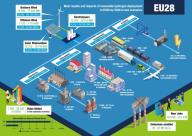Details
- Publication date
- 31 August 2020
- Author
- Fuel Cells and Hydrogen 2 Joint Undertaking
Description
The study analyses the role of hydrogen in the National Energy and Climate Plans (NECPs) and identifies and highlights opportunities for hydrogen technologies to contribute to effective and efficient achievement of the 2030 climate and energy targets of the EU and its Member States.
The study focuses on the potential and opportunities of renewable hydrogen, produced by electrolysers using renewable electricity and of low-carbon hydrogen, produced by steam methane reforming combined with CCS. The opportunities for and impacts of hydrogen deployment are assessed and summarised in individual fiches per Member State.
The study analyses to what extent policy measures and industrial initiatives are already being taken to facilitate large-scale implementation of hydrogen in the current and the next decades. The study concludes by determining the CO2 reduction potential beyond what is foreseen in the NECPs through hydrogen energy technologies, estimating the reduction of fossil fuel imports and reliance, the prospective cost, and the value added and jobs created. National teams working on decarbonisation roadmaps and updates of the NECPs are welcome to consider the opportunities and benefits of hydrogen deployment identified in this study.
The study covers all EU Member States (including the UK) and focuses on the period up to 2030 (i.e. the period of time covered by the NECPs). While there are major opportunities for hydrogen already up to 2030, the large-scale deployment of renewable and low-carbon hydrogen is expected to mainly take off as of 2030. The study hence assesses to what extent policy measures and industrial initiatives are already being taken to facilitate the large-scale implementation of hydrogen in this and the next decades. Finally, the study focuses on the potential and opportunities of renewable hydrogen, produced by electrolysers using renewable electricity and of low-carbon hydrogen, produced by steam methane reforming (SMR) combined with CC(U)S.
The national fiches are available below

